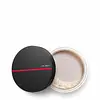What's inside
What's inside
 Key Ingredients
Key Ingredients

 Benefits
Benefits

 Concerns
Concerns

 Ingredients Side-by-side
Ingredients Side-by-side

Synthetic Fluorphlogopite
Mica
Cosmetic ColorantSilica
AbrasiveCalcium Aluminum Borosilicate
Dimethicone
EmollientDistearyldimonium Chloride
Phenoxyethanol
PreservativeTriethoxysilylethyl Polydimethylsiloxyethyl Dimethicone
Skin ConditioningCI 77491
Cosmetic ColorantChlorphenesin
AntimicrobialCI 77492
Cosmetic ColorantCI 77891
Cosmetic ColorantIsopropyl Alcohol
SolventWater
Skin ConditioningVinyl Dimethicone/Methicone Silsesquioxane Crosspolymer
Nacre Powder
AbrasiveMethyl Methacrylate/Acrylonitrile Copolymer
Polysilicone-2
Butylene Glycol
HumectantPolymethylsilsesquioxane
Dimethicone/Vinyl Dimethicone Crosspolymer
Skin ConditioningPolyquaternium-51
Skin ConditioningStearic Acid
CleansingIsobutane
Aluminum Hydroxide
EmollientIsopentane
SolventThymus Serpyllum Extract
Skin ConditioningSericin
Skin ConditioningCitric Acid
BufferingPotassium Sorbate
PreservativeSynthetic Fluorphlogopite, Mica, Silica, Calcium Aluminum Borosilicate, Dimethicone, Distearyldimonium Chloride, Phenoxyethanol, Triethoxysilylethyl Polydimethylsiloxyethyl Dimethicone, CI 77491, Chlorphenesin, CI 77492, CI 77891, Isopropyl Alcohol, Water, Vinyl Dimethicone/Methicone Silsesquioxane Crosspolymer, Nacre Powder, Methyl Methacrylate/Acrylonitrile Copolymer, Polysilicone-2, Butylene Glycol, Polymethylsilsesquioxane, Dimethicone/Vinyl Dimethicone Crosspolymer, Polyquaternium-51, Stearic Acid, Isobutane, Aluminum Hydroxide, Isopentane, Thymus Serpyllum Extract, Sericin, Citric Acid, Potassium Sorbate
 Reviews
Reviews

Ingredients Explained
These ingredients are found in both products.
Ingredients higher up in an ingredient list are typically present in a larger amount.
Aluminum Hydroxide is a form of aluminum. It can be naturally found in nature as the mineral gibbsite. In cosmetics, Aluminum Hydroxide is used as a colorant, pH adjuster, and absorbent.
As a colorant, Aluminum Hydroxide may add opacity, or reduce the transparency. Aluminum hydroxide is contains both basic and acidic properties.
According to manufacturers, this ingredient is an emollient and humectant. This means it helps hydrate the skin.
In medicine, this ingredient is used to help relieve heartburn and help heal ulcers.
There is currently no credible scientific evidence linking aluminum hydroxide in cosmetics to increased cancer risk.
Major health organizations allow the use of aluminum hydroxide in personal care products and have not flagged it as a carcinogenic risk at typical usage levels.
Learn more about Aluminum HydroxideChlorphenesin is a synthetic preservative. It helps protect a product against bacteria in order to extend shelf life. In most cases, Chlorphenesin is paired with other preservatives such as phenoxyethanol and caprylyl glycol.
Chlorphenesin is a biocide. This means it is able to help fight the microorganisms on our skin. It is also able to fight odor-releasing bacteria.
Chlorphenesin is soluble in both water and glycerin.
Studies show Chlorphenesin is easily absorbed by our skin. You should speak with a skincare professional if you have concerns about using Chlorphenesin.
Learn more about ChlorphenesinCi 77492 is also hydrated iron III oxide. It's sole purpose is to give a yellow hue to products.
Iron III oxides are classified as inorganic chemicals for coloring.
Synthetically created Ci 77492 is considered safer than those naturally found. This is because the synthetically created version may contain less impurities. Iron oxides are generally non-toxic and non-allergenic.
Learn more about CI 77492Potassium Sorbate is a preservative used to prevent yeast and mold in products. It is commonly found in both cosmetic and food products.
This ingredient comes from potassium salt derived from sorbic acid. Sorbic acid is a natural antibiotic and effective against fungus.
Both potassium sorbate and sorbic acid can be found in baked goods, cheeses, dried meats, dried fruit, ice cream, pickles, wine, yogurt, and more.
You'll often find this ingredient used with other preservatives.
Learn more about Potassium SorbateSilica, also known as silicon dioxide, is a naturally occurring mineral. It is used as a fine, spherical, and porous powder in cosmetics.
Though it has exfoliant properties, the function of silica varies depending on the product.
The unique structure of silica enhances the spreadability and adds smoothness, making it a great texture enhancer.
It is also used as an active carrier, emulsifier, and mattifier due to its ability to absorb excess oil.
In some products, tiny microneedles called spicules are made from silica or hydrolyzed sponge. When you rub them in, they lightly polish away dead skin layers and enhance the penetration of active ingredients.
Learn more about Silica